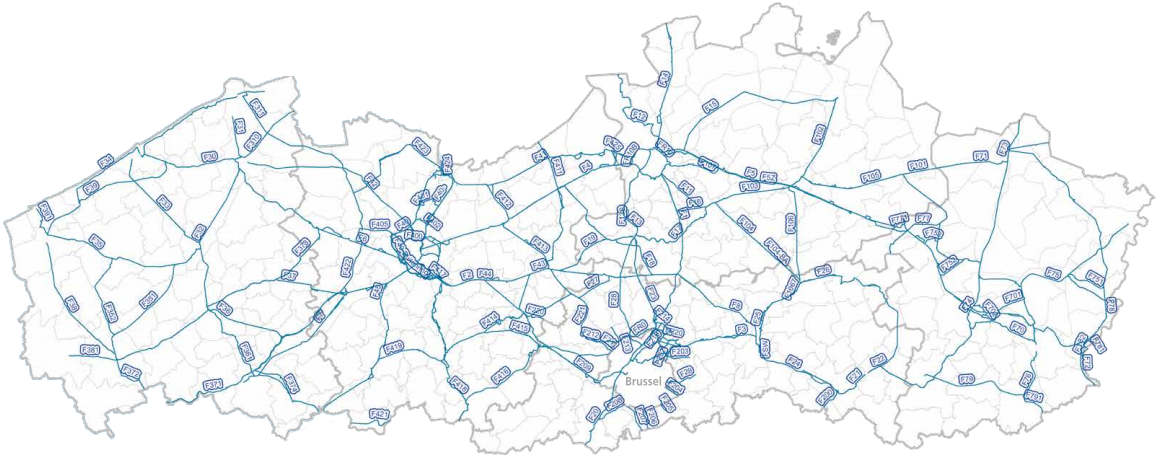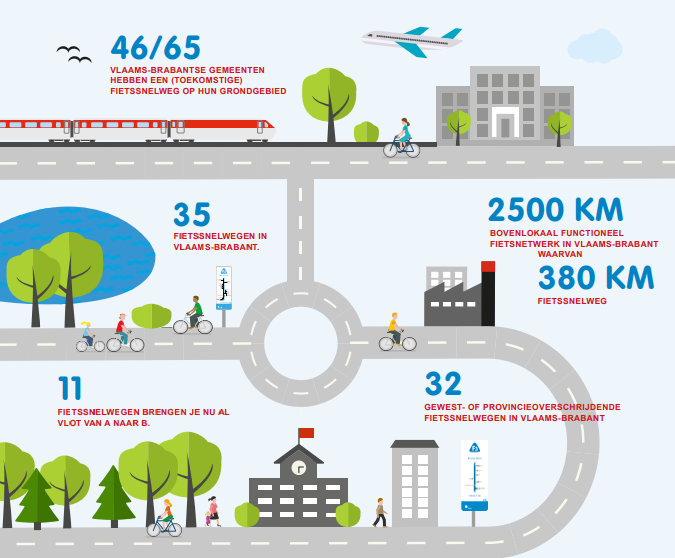
Designing and financing a regional cycle highway network in Flemish-Brabant
The Province of Flemish-Brabant has designed a desired network of cycle highways, part of a wider plan for Flanders, which enables spatial planners to take future cycling infrastructure into consideration. To stimulate the construction of high-quality bicycle infrastructure, the Province and region of Flanders provide subsidies for its realization.
Designing a regional cycle highway network
How do you tackle the huge task of ensuring that an envisioned network of 380 km cycle highways is turned into reality? In the Province of Flemish-Brabant, a desired network of future cycle paths and highways has been designed to make city centers, train stations, and major work hubs more accessible for cyclists. This network is part of a wider plan for a cycling network in Flanders. The lines within the network have an official status and have since their adoption often been included in other planning processes of the Province and municipalities. Whereas some of the defined lines are very concrete, others are more provisional and therefore require further examination to determine the detailed route alignment, for instance, on which side of a railway or canal the line should be placed.
If a municipality wants to realize a piece of the cycle network cutting across their area, they have to undertake two different studies. The first study consists of a “start nota”, which fixes the desired line based on a feasibility study assessing various scenarios and solutions. Once this stage is approved by the Province and Flanders, the municipalities move on to the “project nota” in which the chosen scenario is designed. Both stages include quality control to ensure that the planned infrastructure complies with a set of rules and standards related to comfort and safety. This may for instance be in terms of width, safety measures, comfort of materials, and lightning.
 Incentivizing construction with subsidies
Incentivizing construction with subsidies
Ensuring that the desired network of cycle highways is actually constructed requires considerable financial capacity. That’s why Flemish-Brabant, together with the region of Flanders, provides subsidies for almost all the costs related to the building process. The design costs for the planning process is subsidized with an additional 10 % of the total costs. Whereas the Province and Region provides the funding, the municipality must conduct the studies and complete the building process themselves. Regardless of whether the municipality decides to outsource the study to an agency or not, they will receive the extra 10 % to cover the planning process. However, if the municipality decides to conduct the study themselves, they will only get the refund when and if the infrastructure is realized.
For the costs related to acquiring the necessary land, the subsidy covers 100 % of the costs split between Flanders and the Province. The funding of land acquisition is a relatively new aspect included in the subsidy rules. And although it is currently feasible, it might have to be reconsidered when more municipalities get involved and studies might lead to more advanced and expensive infrastructure.
The infrastructural costs and compensations costs are also funded 100 %. The compensation costs refer to expenses related to natural obstacles such as the removal of trees or when special considerations must be made to protect the natural habitats of local wildlife.
A clear vision leads the way for future developments
The realization of the desired cycle highway network may seem like a daunting task. To make sure the infrastructure is eventually build, Joris van Damme, Project Leader of cycle highways at the province of Flemish-Brabant, emphasizes the importance of having a clear vision in place:
”Fixing the lines is in my opinion also very important when you don’t build the cycle highway in the near future. Without a vision you cannot judge if future special developments will have negative impacts and put the future of the cycle highway at risk.”
A clear envision of a future cycle highway network not only enables the spatial planners to take a future cycle highway into considerations, but also creates the potential of integrating the planned stretch as part of the project itself.
If you want to know more about the financing policy of Flemish-Brabant, click here (in Dutch).
Regions:
Network/Project Involved:
Contact the author
Recent news!
Upcoming events
Contact Us
Avenue des Arts, 7-8
Postal address: Rue de la Charité, 22
1210 Brussels, Belgium









